Abstract
With a global prevalence ranging from 12% to 19%, constipation exerts a severe negative impact on the quality of life of patients. Alleviating constipation can be effectively achieved through abdominal massage. Nevertheless, this method confronts multiple hurdles. For instance, there is a scarcity of professional therapists, the effectiveness of massage varies significantly, and there is an absence of standardized massage techniques. This research presents the design plan of a six-degree-of-freedom multi-technique abdominal massage robot. This robot aims to ease the workload of nursing staff. Structured with a series–parallel configuration, the robot is capable of carrying out four distinct massage techniques: pressing, vibrating, pushing, and kneading. Combining anatomical principles and the meridian theories of traditional Chinese medicine, it constructs a vital model for massage actions, which allows for accurate targeting of massage areas. The hardware system is designed modularly, which facilitates efficient information collection and motor control. In terms of the control strategy, admittance control is utilized to establish a closed-loop system. This ensures that the desired force curve can be precisely tracked during the planning of the abdominal massage trajectory, thus attaining flexible control. Experimental results indicate that within the complex abdominal environment consisting of diverse soft tissues, the six-degree-of-freedom multi-technique abdominal massage robot can generate stable massage interaction forces. It is anticipated that this robot system will standardize massage techniques, unify the patterns of abdominal massage, and offer novel perspectives for the intelligent and multi-technical application of clinical abdominal massage in the future.
1. Introduction
Constipation is a common clinical symptom that can significantly affect patients’ daily lives and overall quality of life. Its global prevalence ranges from 12% to 19% [,,]. The primary physiological function of the colon is to manage and facilitate defecation by propelling intestinal contents to form feces through its mechanical behavior. This behavior includes the active contraction and passive expansion of the intestine, as well as its interaction with the contents of the digestive system. One of the causes of constipation is a disorder of intestinal peristalsis []. For many years, manual therapy has been proposed as a treatment option for relieving constipation on an international scale []. The principle of manual therapy, particularly abdominal massage, involves applying pressure to the anterior abdominal wall, causing the colon to be compressed between the fingers and the posterior abdominal wall []. Numerous studies have shown that abdominal massage can stimulate intestinal peristalsis, reduce colonic transit time, and relieve constipation [,,]. Massage encompasses various movements manual therapists perform on soft tissues to achieve specific therapeutic goals. Depending on cultural backgrounds and needs, massage techniques are categorized into different styles, with Chinese and Swedish massages being the most well known. There is no standardized approach for abdominal massage; instead, techniques are personalized based on the experience of clinical nursing staff. Chinese massage, rooted in the principles of traditional Chinese medicine, often focuses on manually stimulating acupoints that relieve constipation [,,]. This approach is characterized by precision and concentration. In contrast, Swedish massage employs various techniques, such as clockwise pushing along the intestine, kneading, tapping, and vibrating. It is recognized for applying relatively intense pressure across a larger area [,,].
As a non-invasive and effective treatment method, massage therapy has attracted widespread attention due to its painlessness, comfortable experience, easy cooperation, and high safety. Thus, it has generated a substantial social demand. However, the number of experienced manual therapists is currently limited, and the massage treatment process is time-consuming and labor-intensive. The treatment effect also varies depending on the operator’s level, experience, and physical strength, and it is not easy to standardize and unify massage methods. To achieve beneficial results, abdominal massage for constipation is required at least once daily, lasting about 15 min each time. This requirement places a heavy burden on therapists and also creates an economic strain on patients and society.
To alleviate these problems, abdominal massage robots have emerged. By leveraging robot technology, sensing technology, and information technology, abdominal massage robots, as service robots, possess many advantages that manual labor lacks. Robots can not only exert precise force and motion control on patients’ limbs but also record detailed operation data and graphics. They can provide objective and accurate treatment and evaluation parameters for clinical rehabilitation doctors, with the potential to improve rehabilitation effects and efficiency. At the same time, they can eliminate human-related factors, not being affected by the therapist’s level, and ensure efficiency and intensity during the operation process. They can also achieve long-term, stable, and repetitive training, which is beneficial for enhancing the effect of promoting intestinal peristalsis.
In response to the clinical needs of abdominal massage at home and abroad, some professional massage devices have been developed and launched. Some of these products have completed clinical trials and been successfully commercialized. In 2005, the Israeli company ADM (Advanced Dialysis Methods) introduced an electromechanical device called Free-Lax (see Figure 1a). This device has two disks and can switch between three frequencies of 1.25, 1.5, or 1.75 Hz to oscillate inward and outward along the skin’s normal direction to push the abdomen []. In 2014, the Spanish company usMIMA and the Guttmann Neurorehabilitation Institute jointly launched an automatic massage device, MOWOOT (see Figure 1b). This device is fixed to the patient’s abdomen with Velcro and provides a massage belt for rhythmic intermittent colonic exo-peristalsis (ICE) treatment [,]. In 2016, China disclosed an intestinal management training massaging device [] (see Figure 1c). There is a DC motor inside the housing, which is connected to an arc-shaped vibrating block on the rear surface of the housing. It can switch between different power levels but requires manual operation to control the massage intensity []. In 2018, South Korea disclosed an automatic abdominal massaging device, Bamk001 (see Figure 1d), used for pressurized massage and warming the patient’s abdomen. The device is divided into five modules, each consisting of an airbag and a thermoelectric module. The airbags of this device massage the intestinal movement in a clockwise direction, and the thermoelectric module can raise the temperature around the patient’s abdomen to 40 °C for warming [,]. In 2018, China disclosed a nursing massage robot for promoting digestion (see Figure 1e), which includes a lying bed, side massage devices, an upper massage device, and an annular mounting plate. The annular mounting plate is installed on the upper-end surface of the middle part of the lying bed. The side massage devices are symmetrically installed on the lower inner-side surface of the annular mounting plate, and the upper massage device is installed on the upper inner-side surface of the annular mounting plate []. In 2020, China disclosed a new type of abdominal massage device (see Figure 1f). The massage is achieved through the rotation of rollers on a hinge shaft and can be heated to keep the abdomen warm []. In 2021, China disclosed a digestive medicine abdominal massage device (see Figure 1g). The user must lie on the bottom plate, and the lifting and sliding mechanisms are adjusted manually. There are multiple magnetic balls arranged in an annular array on the outer side of the rotating cylinder. A protective cloth and a cleaning cloth cover the heating layer. The controller can start the rotating cylinder and the heating mechanism to achieve massage []. These studies show that about half of the related devices are still in the conceptual design or prototype development stage. Although commercialized abdominal massage devices can achieve essential massage functions, their intelligence levels still have significant limitations, especially in precise force control, intelligent path planning, and bio-feedback functions, lacking in-depth research.
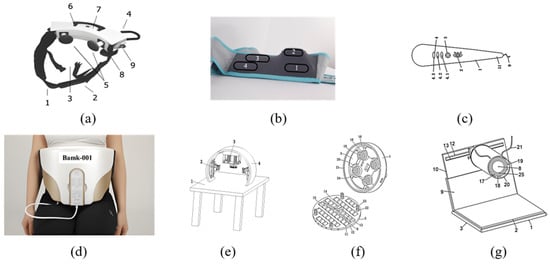
Figure 1.
Research status of abdominal massage robots and device: (a) Free-Lax []; (b) MOWOOT [,]; (c) an intestinal management training massaging device [,]; (d) Bamk001 [,]; (e) a nursing massage robot for promoting digestion []; (f) a new type of abdominal massage device []; and (g) a digestive medicine abdominal massage device [].
Massage devices with a relatively high degree of intelligence are currently mostly non-wearable large-scale platforms, and their action areas are mostly parts with a large proportion of bones, such as the back and limbs. There are few mentions of devices that can act on the abdomen. Abroad, the concept of a massage platform was proposed earlier. In 2003, K.C. Jones et al. from San Jose State University in the United States [] studied a massage mechanism based on a 6-degree-of-freedom robotic arm PUMA 562, which could knead the lumbar region of the patient’s back. This research collected interaction forces based on a single-axis pressure sensor and could generate adaptive motion trajectories. In 2016, the AiTreat team from Nanyang Technological University in Singapore [] launched the physiotherapy robot EMMA (Figure 2a), which used 3D vision technology to analyze the patient’s body and understand the condition. In 2018, the French company Capsix Robotics [] developed the IYU massage robot (Figure 2b), which used a redundant robotic arm KUKA LBR Med with a massage glove at the end and could complete operations such as pressing, squeezing, pushing, and kneading. It could adapt to the patient’s body shape by combining 3D vision technology. In 2009, Hou Peng et al. from Southeast University [] developed a 4-degree-of-freedom household massage robot (Figure 2c), which could achieve point-pressing, tapping, and kneading functions by switching massage heads. This method could effectively reduce the volume of the mechanism. In 2012, the team led by Jiao Chengbin from Shandong Jianzhu University [] studied the LLR-1 traditional Chinese medicine massage robot (Figure 2d). Through the cooperation of connecting rods, lifting motors, and vibrating motors, massage techniques such as palm-kneading, palm-pressing, palm-pushing, vibrating, and rolling could be achieved. Subsequently, Xie Jun [,,], Lu Shouyin [], and others upgraded its second- and third-generation prototypes, equipped with an emergency stop trigger mechanism, and improved the safety mechanism. In 2012, Wang Yiran et al. from Jinan Foreign Language School [,] studied the JZMR-I traditional Chinese medicine massage robot (Figure 2e). The robot’s body consisted of a posture adjustment platform, massage hands, robotic arms, etc. The two robotic arms of the lifting platform could adjust their postures independently to locate the massage area. In 2015, Su Yonglin from Yanshan University [] designed a massage robot based on a decoupled parallel mechanism. This mechanism proposed a two-translation–one-rotation decoupled parallel mechanism by combining the characteristics of series–parallel structures, reducing the coupling of the mechanism and simplifying the complexity of subsequent control research on massage robot mechanisms. In 2021, Kong Yixiao from North University of China [] studied a hybrid-connected robot based on traditional Chinese medicine massage techniques, based on a 1P + 5R (one prismatic joint and five revolute joints) series-type massage robotic arm and a 3-PSS/PRR (two-translation–two-rotation degree-of-freedom parallel mechanism) parallel-type massage device, and verified the rationality of its design with a workspace cloud map, but did not manufacture a prototype. Some industrial collaborative robots in the manufacturing field can be applied to the medical field for massage operations by cooperating with a static platform. The AUBO collaborative robot (Figure 2f) can provide real-time feedback on massage force, accurately plan massage trajectories, dynamically adjust massage trajectories, and store data []; the UR collaborative robot developed by the Danish innovative industrial robot manufacturer Universal Robots (Figure 2g) has the characteristics of flexibility and low noise through compliant control []; and the 7-degree-of-freedom redundant robotic arm DLR studied by the German Aerospace Center has variable-stiffness drive motors configured at each joint of the robotic arm and can complete high-demand operations such as massage [].
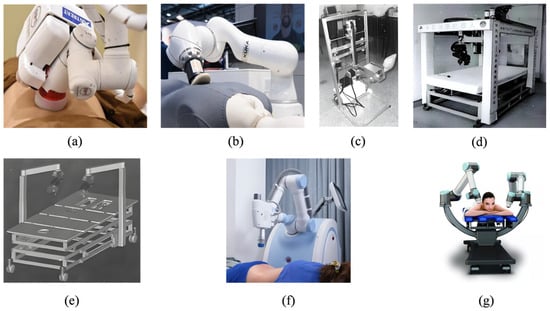
Figure 2.
Massage robots used on various parts of the human body: (a) the physiotherapy robot EMMA []; (b) the IYU massage robot []; (c) a 4-degree-of-freedom household massage robot []; (d) the LLR-1 traditional Chinese medicine massage robot []; (e) the JZMR-I traditional Chinese medicine massage robot [,]; (f) The AUBO collaborative robot []; and (g) the UR collaborative robot [].
The current research on abdominal massage devices mainly focuses on the mechanical structure design and function realization of the devices. However, to improve the intelligence and accuracy of massage devices, research on control algorithms is critical. The application of control algorithms for massage robots provides theoretical and technical support for controlling the massage force and precise massage of the devices. Common control algorithm directions currently include PID control algorithms, force/position hybrid control algorithms, impedance control algorithms, and neural network control algorithms. The PID control algorithm ensures the stability of the output force through closed-loop feedback adjustment and is widely used in traditional Chinese medicine massage robots. For example, Zixin Huang et al. from Wuhan University of Technology [] selected the incremental PID algorithm to achieve closed-loop control, ensuring the stable output of the end-effector of the traditional Chinese medicine massage robot. The team led by Zhang Bangcheng from Changchun University of Technology [] used a PID controller to make the positioning accuracy have a maximum error of less than 0.1 mm and a massage force accuracy error of less than 5% based on stable operation. The force/position hybrid control algorithm solves the contradiction between the position servo and the stiffness of the mechanical structure. Professor Gautam Srivastava from Brandon University [] led a team to use high-precision force/position hybrid control to solve the contradiction between the position servo of the robot’s end-effector and the stiffness and flexibility of the mechanical structure’s force, thus completing active safety detection and protection. In 2022, the research team where Huixu Dong [] was located designed a high-precision force/position hybrid control strategy, which could apply a maximum pressure of 5 kg in the z-axis direction and maintain a force fluctuation of ±0.1 kg during the force control process, with a response time of 6 s. In the application of impedance control algorithms, the team led by Mahdi Khoramshahi from Sorbonne University in Paris [] proposed a method based on dynamic systems and support vector regression (SVR), allowing the robot to independently control the force along the surface normal direction when moving in the tangential plane and maintaining a force fluctuation of ±0.2 kg during the movement to ensure the effectiveness and comfort of the massage. The research team of Ren C. Luo [] enhanced safety and contact detection through impedance control based on Cartesian coordinates for a humanoid two-arm robot to meet the adaptability to different force requirements during the robot’s tapping massage process. Neural network control algorithms, combined with reinforcement learning and deep learning, improve the accuracy and adaptability of force control. For example, in 2023, Professor Wen Wu from Zhujiang Hospital of Southern Medical University and Professor Meng Xiao from the University of South China [] led a team to establish a dynamic relationship model between the end-effector of the robot and the skin contact and used the impedance control model for force control. By combining neural networks and the cross-entropy method, a reinforcement learning algorithm was constructed to search for control parameters. The experimental results showed that the force control error was controlled within ±0.2 N. In 2024, Professor Xiaoqing Zhang from Shanghai University of Engineering Science [] led a team to perform 3D reconstruction and path planning of the massage area through deep learning for back area extraction and acupoint recognition, and the developed adaptive force tracking control strategy could control the contact force error within 0.2 N. These studies not only promoted the development of massage robot control algorithms but also laid a technical foundation for the realization of efficient, safe, and personalized massage robots.
In summary, abdominal massage techniques have not been unified in various countries or even in different medical institutions in China, and they are still in a state of characteristic operations. A performance comparison and analysis of existing abdominal and non-abdominal massage devices and robots is presented in Table 1 as follows. It can be seen from Table 1 that the research on robots or devices for abdominal massage is limited. The existing research can be divided into two types: wearable and non-wearable. It can be seen that the actuators of wearable devices are mostly airbag structures or a small number of mechanical action heads using balls or rod-like mechanisms. The action points are fixed and limited, the action techniques are single, and most are based on the pressing method. Non-wearable devices can be divided into manual-held assistive mechanisms and the combination of a stable static platform structure and a flexible, dynamic platform structure, such as robotic arms or large-scale adjustment platforms combined with end-effector massage structures, according to their intelligence levels. Manual-held devices lack intelligence; the latter have improved intelligence, but their manufacturing costs have increased significantly. At the same time, the overly large size of the devices may bring some negative experiences, such as psychological pressure, to users, and their application to the abdomen, a part with multiple soft tissues, is still blank. Regarding intelligent control, researchers also focus on precise force control and trajectory planning. When using an abdominal rehabilitation massage robot for massage, it is necessary to consider the safe force threshold range of different people and the coordination of massage techniques and massage forces when moving between different massage points.

Table 1.
Comparative analysis of the performance of abdominal massage equipment and robots.
Therefore, based on the need for a standardized and intelligent abdominal massage, our team has established a new six-degree-of-freedom multi-technique abdominal massage robot system. This system uses a series–parallel hybrid combination structure, which can cover the abdominal massage area and achieve four different massage techniques: pressing, vibrating, pushing, and kneading. By combining admittance control, PID control, and adaptive fuzzy control, a closed-loop control system is formed, enabling fast and accurate tracking of the desired force curve during the abdominal massage trajectory planning and realizing flexible control of the robot. The robot can apply mechanical external forces within a safe range to the abdomen, thus being expected to promote or drive intestinal peristalsis.
In summary, given the current status of abdominal massage and the shortcomings of existing massage equipment, this paper is dedicated to the development of a new six-degree-of-freedom multi-manipulation abdominal massage robot system. Subsequent chapters will focus on this system in detail: Section 2 mainly introduces the materials and methods, covering the design goals of the robot, mechanical structure design, kinematics analysis, and the design of hardware and software control systems; Section 3 demonstrates the performance results of the robot system through simulation verification and practical experiments; Section 4 discusses the research results, analyzes the advantages and disadvantages of the system, and proposes future research directions in order to provide new ideas and methods for the intelligent development of clinical abdominal massage.
2. Materials and Methods
2.1. Design Objectives of the Abdominal Massage Robot
Based on the application status of abdominal massage techniques at home and abroad, combined with the anatomical feature that the position of the internal colon in the abdomen cannot be directly observed by the naked eye and the high-precision requirement for the massage position, this study selects Chinese massage as the core intervention method. Chinese massage is based on the theory of traditional Chinese medicine, meridian acupoints. By precisely stimulating specific acupoints through techniques, it can effectively promote intestinal peristalsis and blood circulation, thereby relieving constipation symptoms. Its techniques are delicate and highly targeted, which is highly consistent with the technical requirements of an intelligent and precise control system and provides a theoretical basis and technical feasibility for the intelligent realization of the massage robot. This study determines that the bionic abdominal massage techniques of the robot comprise four types: pressing, vibrating, pushing, and kneading. In human anatomy, three mutually perpendicular axes are defined: the vertical axis, the sagittal axis, and the coronal axis. When a subject lies supine on a nursing bed, the vertical axis of the human body is set as the x-axis, the coronal axis as the y-axis, and the sagittal axis as the z-axis. Based on this, the kinematic expressions of the four massage techniques are as follows (as shown in Figure 3). Pressing method: press vertically downward, moving straight along the z-axis. Vibrating method: continuously and rapidly vibrate up and down at a specific part with a high frequency, which also moves in a straight line along the z-axis but with a higher frequency than the pressing method. Pushing method: the force-applying part closely adheres to the skin and moves unidirectionally and evenly; it moves slightly downward along the z-axis and simultaneously moves approximately in the XOY plane. Kneading method: the force-applying part makes small-amplitude circular kneading motions; it rotates in a circle around the z-axis based on the force-applying point.

Figure 3.
Kinematic decomposition of four massage techniques: (a) pressing; (b) vibrating; (c) pushing and (d) kneading. In the figure, the red arrows and letters represent the coordinate axes with the acting point as the center, and the blue arrow indicates the direction of the applied force.
Anatomically, the abdomen is divided into nine regions via two horizontal and vertical lines to localize organs and guide palpation. The ascending, transverse, descending, and sigmoid colons exhibit distinct mobility ranges. Integrating TCM meridian theory with anatomical mapping [] (GB/T 12346-2021), this study identifies constipation-relief acupoints adjacent to colonic segments: Zhongwan (CV12), bilateral Tianshu (ST25), bilateral Daheng (SP15), Fujie (SP14), and left Fushe (SP13). Per GB/T 23237-2009 standards [], critical landmarks including Tiantu (CV22), Qigu (CV15), Shenque (CV8), Yunmen (LU2), and rib edges are incorporated to calculate proportional “cun” measurements (Table 2). Spatial coordinates of target acupoints are derived through inter-landmark distance ratios (e.g., Yunmen-Yunmen = 12 cun, Tiantu-Qigu = 9 cun) and digital scaling rules. This model (see Figure 4) enables vision-free robotic localization of massage targets through umbilical calibration, eliminating pre-procedural imaging requirements while ensuring anatomical safety.

Table 2.
Calculation basis for the measurement of one-cun distance on the human body based on the anthropometric method for acupoint location in GB/T 23237-2009.
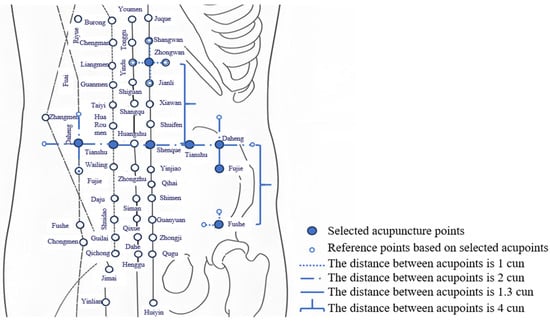
Figure 4.
Key-point model for abdominal massage action.
2.2. Mechanism Design
According to the design objectives of the robot, our team proposed a mechanical modeling idea for the six-degree-of-freedom multi-technique abdominal massage robot system (as shown in Figure 5). From the perspective of structural analysis, the robot has three layers of functional structures: the upper-layer structure is a track structure, the middle layer is a parallel structure, and the lower layer is a series structure. The design concept of the upper-layer track structure is derived from the essential feature of the colon, which is an inverted U. This track uses the principle of gear meshing. A rotary motor (Motor 1) drives a gear, enabling the movement of the end-effector along a fixed trajectory on the toothed structure that fits the track. The design of the track layer enables the projection of the end-massage actuator’s movement route on the human body’s frontal plane to present the target inverted U-shaped trajectory, initially conforming to the trend of the intestine, as shown in Figure 6. The middle-layer parallel structure comprises three push-rod motors and a slide rail that can passively adapt to different length dimensions. The two push-rod motors (Motor 2 and Motor 3) are in the vertical direction and are the main features of the parallel structure, forming an outer-track fulcrum point centered on Motor 1 and an inner-track fulcrum point centered on Motor 3, respectively. It is worth noting that the inner-track fulcrum point centered on Motor 3 is fixedly installed on the upper layer, while the outer-track fulcrum point centered on Motor 1 and the push-rod motor Motor 2 are installed on the same platform to move flexibly on the upper-layer track. The design of the parallel structure is to achieve the synchronous up-and-down movement of the middle- and lower-layer structures and the adjustment of the tilt angle of the end-massage actuator, that is, two degrees of freedom in the up-and-down and tilt directions. Then, a push-rod motor (Motor 4) is combined with a slide rail that can passively adapt to the distance between the inner and outer track fulcrums (that is, the distance between points and ) to accurately control the position of the end-massage actuator on the slide rail, thereby controlling the massage trajectory of the end-massage actuator in the entire space. The lower-layer series structure is serially connected with two motors. A rotary motor (Motor 5), combined with a bevel-gear commutation mechanism and a crank–rocker mechanism, can achieve the bionic trajectory of the kneading method. It is worth mentioning that most of the trajectories for realizing the kneading method are characterized by the rotation of the end-massage mechanism with a fixed center. However, after combining with the crank–rocker mechanism, the kneading method can mimic the movement of a human hand. The distal rocker controls the center of the end-massage actuator to present a closed-loop circular-like shape. Due to the crank–rocker mechanism’s structural characteristics, the end-massage actuator’s center A voice-coil motor (Motor 6) is installed under the crank structure, which can directly achieve the vibration method and perform pressing at different frequencies. The end-massage actuator comprises a pressure sensor and a silicone softball.
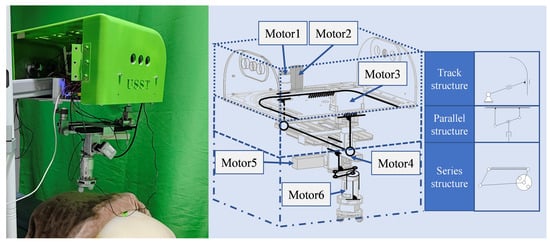
Figure 5.
Prototype and design concept diagram of the six-degree-of-freedom multi-technique abdominal massage robot without an external adjustment frame.
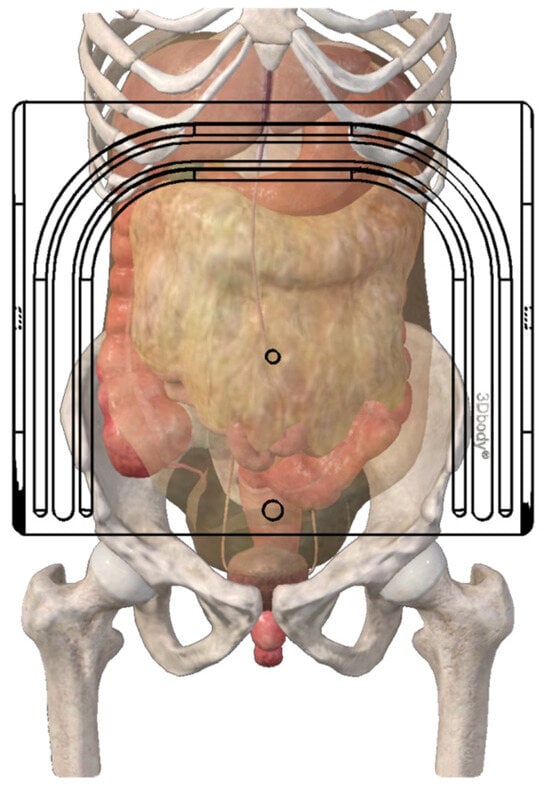
Figure 6.
Corresponding diagram between the inverted U-shaped trajectory of the upper-layer track layer and the intestinal tract trend.
2.3. Kinematic Analysis of the End-Effector
The abdominal massage robot has three layers of functional structures, all of which serve the motion trajectory control of the end-massage actuator. In this part, this paper analyzes the kinematic characteristics of the abdominal massage robot during the massage on the frontal plane of the human body. The schematic diagram of the upper-layer track structure on the frontal plane of the human body is shown in Figure 7.
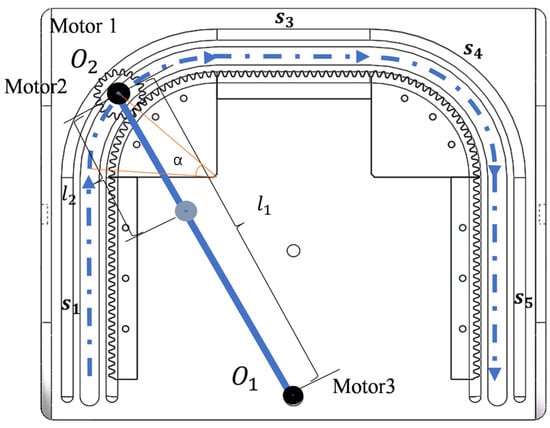
Figure 7.
Top view of the upper-layer track structure.
As shown in the figure, let the distance between and be , and the size of is related to the number of rotation circles of the gear driven by Motor 1. Therefore, the meshing situation of the gear and the toothed structure is analyzed. The parameters of the moving gear are , and the pitch-circle diameter is . The parameters of the gear and rack in the static toothed structure are , and the total path length is . The total number of rotation circles of the moving gear is circles. In this structure, the shortest distance from the outer fulcrum to the section is . Since the upper-layer track structure is axisymmetric, only the left-hand part (that is, the left-hand part of , , and ) is analyzed. A rectangular coordinate system is set with the inner fulcrum as the origin. The outer fulcrum moves on the segmented track. Let the rotation degree of the motor be and the center point of the end-massage actuator be point . The following equations can be obtained:
For the section:
The coordinates of the point can be expressed as follows:
The equation of the line can be expressed as follows:
Then, the coordinates () of point are
For the section:
Let
Then, the coordinates of the point can be expressed as follows:
The equation of the line can be expressed as follows:
Then, the coordinates () of point are
For the section:
Then, the coordinates of the point can be expressed as follows:
The equation of the line can be expressed as follows:
Then, the coordinates () of point are
Obtaining the coordinates of point provides a basis for judging the robot’s trajectory planning and position control.
2.4. Hardware Control System of the Abdominal Massage Robot
The hardware system of the six-degree-of-freedom multi-technique abdominal massage robot adopts a modular design method, including a central control module, an execution module, a sensor module, a power supply module, and a remote control module. The main control module is a 32-bit microcontroller (MCU) STM32F407 (Zhengdian Yuanzi, Guangzhou, China). The execution module includes push-rod motors, DC brushed motors, 25AIS series DC reduction motors, and voice-coil motors. Specifically, the push-rod motor MNTL (Luilec, Changzhou, China) has a maximum stroke of 75 mm and a maximum load-bearing capacity of 60 N. There are two types of rotary motors. One is a brushless DC motor MD25AIS80-24-00130-1R (Shanghai Siheng motor, Shanghai, China), with a rated voltage of 24 V, a rated speed of 3000 ± 10% rpm, and an output torque of 0.105 NM. It is equipped with a built-in reducer (reduction ratio 1:100). The other is a DC geared motor JGB37-520 (Bihui Digital, Shenzhen, China), with a rated voltage of 12 V, a rated speed of 15 rpm, and an output torque of 3.43 Nm. The voice-coil motor 30VC001 (Smooth, Ningbo, China) has a rated voltage of 12 V, a thrust of 0.6 kg, and a frequency range of 0–100 Hz. A miniature tension–compression sensor SBT674 (Sibatuo, Guangzhou, China) is selected to measure the interaction force between the end-effector massage structure and the human abdomen. It has a measurement range of 0–20 N, a signal voltage accuracy of 0.06 mv, and an error ≤ ±0.3%, enabling real-time and accurate monitoring of changes in the massage force. The power supply module is a 24 V battery. The remote control module includes an HC-05 Bluetooth module (Telesky, Shenzhen, China) and an upper computer. The central controller and the other four modules form a one-master–four-slave distributed structure. The model of the motor driver is AQMD2403NS-M2B (Asco Technology Co., Ltd., Chengdu, China). The data exchange between each module uses RS-485 serial communication and Bluetooth transmission. RS-485 can simultaneously perform one-to-multiple data transmission using differential signals, with a maximum transmission distance of 1 km. The block diagram of the system hardware structure is shown in Figure 8.
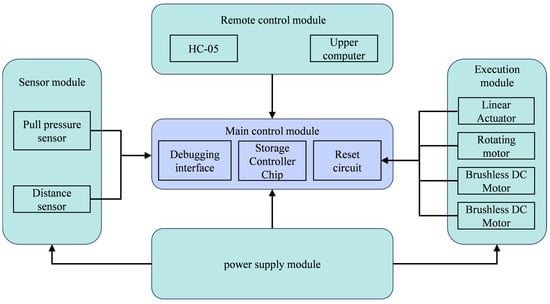
Figure 8.
Block diagram of the hardware system.
2.5. Software Control System of the Abdominal Massage Robot
The abdomen is the body region located between the pelvis and the chest. In human anatomy, the structure of the abdomen is distinct from other body parts. It is mainly composed of soft tissues and lacks significant bony support. This area contains abundant muscle and fat layers and houses multiple crucial internal organs, such as the stomach and intestines. Therefore, abdominal massage and care require special caution. Given its unique structure and essential functions, the safety of abdominal massage demands particular attention. Considering the particularity of the massaged area, this paper combines admittance control, PID control, and adaptive fuzzy control technologies to form a closed-loop control system. This system enables the rapid and accurate tracking of the desired force curve during the abdominal massage trajectory planning, achieving flexible control of the robot.
2.5.1. Admittance Control
The control method for human–machine interaction force mainly adjusts the error between the actual running and the reference trajectory according to the patient’s active acting force. This error can be represented by impedance control [,]. The core concept of impedance control is to match the robot’s impedance with that of the environment, regarding the robot system as an integrated mass–spring–damper virtual environment, as shown in Figure 9.
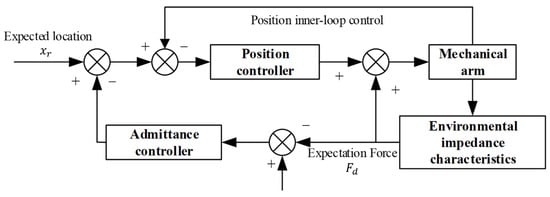
Figure 9.
Structure diagram of position-based impedance control.
Impedance control uses sensors to collect and record the force information generated between the robot and the environment, which is inputted into the controller for processing. The controller calculates the robot’s motion trajectory and force output based on the impedance values of the robot and the environment, effectively controlling the interaction between the robot and the environment. Traditional impedance control [] has two types: position-based impedance control (admittance control) and torque-based impedance control. The control objectives of both are to achieve specific spatial tasks:
where , , and are non-singular coefficient matrices designed manually, which are positive-definite virtual mass, damping, and stiffness matrices, respectively. is the task-space configuration of the control-target coordinate set, and . For robots with torque-based impedance control, the displacement of the end-point is sensed through sensors. Then, the joint forces and torques are controlled to generate the resultant force acting on the robot, thus realizing the transfer function from motion to force. Currently, many robots adopt a design that directly controls joint torques, and most use position-based impedance control [] for the force–position hybrid control of robots. The position-based impedance control method also controls the robot’s motion by designing a control law. This paper uses admittance control to achieve the effect of tracking the massage interaction force. The end of the abdominal massage robot is equivalent to a second-order impedance system, and the relationship of the mass–damping–spring model between the position/velocity and the interaction force is constructed:
where and represent the desired and actual accelerations, velocities, and displacements of the end of the massage head, respectively. represents the error between the desired massage force and the actual massage force. The skin environment acting on the end of the massage head is modeled as a linear spring, which satisfies the following relationship between force and displacement:
where is the stiffness matrix, taken as a positive diagonal matrix. represents the force exerted by the massage head on the skin, represents the vector of the actual position of the massage head, and is the environmental position. It is easy to see that it is decoupled in all directions. Therefore, during the analysis process, the direction perpendicular to the skin is considered first. Combining and simplifying Equations (15) and (16), since the stiffness of the massage head is a constant, the expression of the contact force dynamic equation is obtained:
According to the working principle of the impedance control system, the input of the impedance part is the contact-force error, and the output is the correction of the given reference trajectory. Therefore, the transfer function of the impedance can be expressed as follows:
If the position-control error of the robot is too small to be ignored, the contact-force error in the specified direction is
According to classical control theory, when the system reaches a steady state, the static-force error is zero:
If the static-force error is to be zero, there are two cases. The first case is to make , but represents the rigidity matrix of the interaction between the robot and the environment and cannot constantly be zero. The second case is when the parameters of the required position satisfy the following relationship:
Therefore, the required position can be calculated based on the accurate environmental position and stiffness. Then, the massage force can be controlled to be consistent with the expected force. can be controlled to reach the predicted massage force within a certain period. However, in an actual massage scenario, it is impossible to accurately obtain the exact environmental position and stiffness due to the interference of various ecological factors. Therefore, new methods need to be introduced.
2.5.2. Adaptive Fuzzy Variable Admittance Control
In the massage process, the admittance model of human–machine interaction is not fixed. Therefore, the human–machine interaction force and the change rate of the human–machine interaction force during the massage of different patients are used as control variables to adjust the admittance control parameters in real time so as to achieve a better massage effect. At the same time, when the end of the robot contacts the environment, a reference position should be given to ensure the continuity of the contact. An additional correction is required for the robot to change from non-contact to stable contact with the environment:
where and are the differential factor and the proportional factor, respectively, and is the supplementary term. The adjustment rules of these three parameters are obtained using the Lyapunov stability design method:
refers to the above-mentioned three parameters, is a formula related to the force error and is ignored, is one or the force error or the force-error rate, and and are positive-gain decimals. Thus, the control rate of the adaptive controller is obtained:
Due to the interference of many factors, such as the patient’s body shape, organ collision, and clothing friction [,], fixed impedance parameters cannot enable the robot to stably achieve force tracking in the complex environment of the abdomen. The controlled object is the human abdomen, and its soft tissue presents highly nonlinear (such as contour fluctuations caused by respiration) and time-varying (abdominal stiffness differences also exist in different patients) characteristics. Traditional model-dependent methods (such as PID) make it difficult to capture such dynamic characteristics in real time. Fuzzy control describes uncertainty through language rules (such as “if the force error is large and the rate of change is negative, the stiffness coefficient will be greatly reduced”), and robustness can be achieved without precise modeling. This study is based on the theory of traditional Chinese medicine meridians and anatomical positioning, and clinical experience needs to be transformed into control rules. The fuzzy controller can directly encode language logic such as a “smooth transition of pressing force as the error decreases”. The fuzzy adaptive algorithm can adjust the stiffness matrix K and damping matrix B in real time. The system adopts the STM32F407 microcontroller, and the computing resources are limited. A fuzzy rule base occupies little memory and can meet the needs of embedded real-time control. Therefore, a fuzzy controller [] is added based on the original control strategy to adjust the impedance parameters in real time according to environmental changes, improving the control accuracy of the robot. The core of the fuzzy controller [] is to design the rules of the fuzzy controller.
In this design, the Gaussian and triangular membership functions are used for the input and output, respectively.
The Gaussian function formula is
where c is the center of the fuzzy set and the width of the Sigma distribution.
The formula for the triangular membership function is as follows:
Through self-conducted massage-force experiments, it is known that the regular massage-force range of the abdominal massage robot is [0, 20], and the force-error universe range is [−0.5, 5]. The output of the fuzzy controller is set as the stiffness coefficient matrix K and the damping coefficient matrix B. The fuzzy set parameters are set as shown in Table 3:

Table 3.
Fuzzy set parameter setting table.
The fuzzy rules are formulated and presented in a table as follows:
- If the force error E is positive and the force-error change rate EC is also positive, the error increases in the positive direction. Applying too much force may exceed the patient’s tolerance range. Currently, the controller should output the reverse maximum voltage NB for control.
- If both the force error E and the force-error change rate EC are negative, the error increases in the opposite direction. In this case, the controller should output the positive maximum voltage PB for control.
- If the force error E is positive while the force-error change rate EC is negative, the error decreases in the opposite direction. The controller can only output the standard PM control.
- If the force error E is zero and the force-error change rate EC is also 0, the error decreases in the opposite direction. The controller outputs a voltage of ZO.
The force error E or the force-error change rate EC is divided into five levels: negative significant (NB), c (NS), zero (ZO), positive small (PS), and positive large (PB), with a total of 25 fuzzy control rules written in the form of fuzzy rules. All the rules are input into MATLAB R2020a for fuzzy controller simulation. The fuzzy control rule table is shown in Table 4, which shows the established fuzzy logic control laws.

Table 4.
Fuzzy control rule table.
This article selects the Centroid Method as the defuzzification method.
where is the aggregated membership function, output as force error.
2.6. Safety Strategies for the Abdominal Massage Robots
In summary, our team has proposed a new six-degree-of-freedom multi-technique abdominal massage robot system. The overall design of this system is shown in Figure 10.
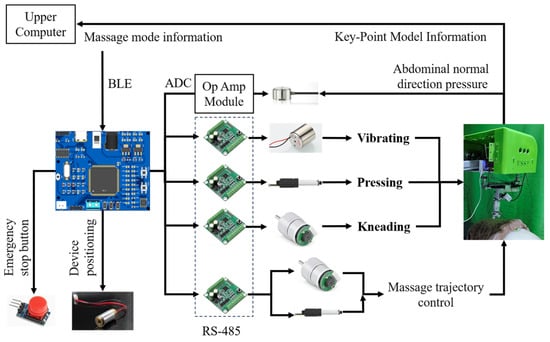
Figure 10.
Overall flowchart of the six-degree-of-freedom multi-technique system.
In the design of the entire system, a series of comprehensive and rigorous safety mechanisms are adopted to effectively ensure the safety of patients during the massage process. These mechanisms cover two aspects: hardware and software.
2.6.1. Hardware Safety Strategies
Force Limitation and Monitoring Mechanism: A uniaxial force sensor is installed in the end-massage structure of the robot. Its main function is to conduct real-time and accurate monitoring of the interaction force between the robot and the patient’s abdomen. To ensure the safety of the massage process, the system has strict safety thresholds set. The determination of these safety thresholds is derived from a research project on “Abdominal Interaction Force–Displacement Data Collection” carried out simultaneously by the research team. This research was conducted under the strict supervision of the ethics committee. By recruiting multiple healthy volunteers, the same massage head was used to perform massage operations on the volunteers’ abdomens, and their subjective feelings about the abdominal massage force during the process were recorded simultaneously. Once a volunteer felt discomfort, the massage operation would be immediately stopped, and the massage device would quickly move away from the body. At the same time, the force and pressing displacement data at that moment were recorded. By synthesizing the data of multiple volunteers, their safety thresholds were obtained and used as an important reference for the safety control of the robot system, thus effectively protecting the safety of subjects during the massage process.
Emergency Stop Device Setup: To deal with possible sudden dangerous situations, the system is equipped with an emergency stop button and a power switch, and these devices are all reasonably placed in positions accessible to operators. When a danger occurs, the operator can react quickly and press the emergency stop button. Once triggered, this button will make the robot stop running immediately and automatically execute a reset operation, moving the robot away from the body to avoid further harm to the patient. The power switch button, on the other hand, can cut off the power supply of the robot instantly, fundamentally cutting off the power source of the robot and further ensuring safety.
Safe Mechanical Structure Design: From the perspective of mechanical design, only the end-massage structure of this robot comes into contact with the patient’s abdomen, while the rest of the parts are isolated from the body. This effectively reduces the risk of safety accidents caused by other parts of the robot contacting the body. In addition, the robot is designed with a universal installation module. In this study, this module is connected to a portable and movable unpowered mechanical platform. In an emergency, the operator can manually rotate the rotatable structure on the unpowered mechanical platform to quickly move the robot away from the body, providing additional safety protection for dealing with sudden situations.
2.6.2. Software Safety Strategies
Application of Safety Control Algorithms: The control algorithm selected in this study can accurately track the desired force curve, ensuring that the force applied to the patient’s abdomen remains within a controllable range throughout the massage process. This effectively avoids discomfort or harm to the patient caused by excessive or insufficient massage force.
Fault Detection and Diagnosis System: A dedicated fault detection program is written to monitor the operating status of the robot in real time. This program can acutely detect abnormal situations during the robot’s operation, such as excessive motor current and sensor failures. Once an abnormality is detected, the motor will automatically cut off the power supply and stop running, and the emergency stop program will be triggered in a timely manner. At the same time, motors that have not experienced problems will also immediately stop running and execute a reset operation, quickly moving the robot away from the body to minimize the possibility of harm to the patient caused by the fault.
Strict Operating Specification Requirements: During the use of the robot, strict operating specifications are followed, and professionals are arranged to supervise the process. These professional supervisors have in-depth knowledge and understanding of the robot’s performance, operation methods, and safety. They can respond accurately and effectively at the first moment when an emergency occurs, ensuring the safety of the patient.
3. Results
3.1. Simulation Verification
To verify the effectiveness of the designed adaptive fuzzy variable admittance control algorithm, force curve tracking simulations and comparisons of PID, fixed impedance, and adaptive fuzzy variable impedance were carried out in the Simulink module of MATLAB [,]. The simulation results are shown in Figure 11. A sine-function signal with an amplitude of 2 was set as the desired massage force curve to compare the effects of different control strategies. During the simulation, the unit operation cycle was set to 8 ms. B = 100 and K = 100 were selected for the fixed impedance. As shown in Figure 11, although the traditional PID control and the admittance controller can track the desired force curve [], their errors and control effects are relatively weak. The tracking stability of the admittance control with the added adaptive algorithm has been achieved, and the end-effector force fluctuation has been improved. However, due to the imprecision of the admittance parameters, there is still a small error between the tracking force and the desired force. Compared with the former two, the adaptive admittance control strategy with the fuzzy-processing algorithm can stably control the error within 0.2 N. For the admittance control adjusted by the fuzzy-processing algorithm, the tracking-effect stability and the tracking error are superior to those of the traditional fixed-impedance control.
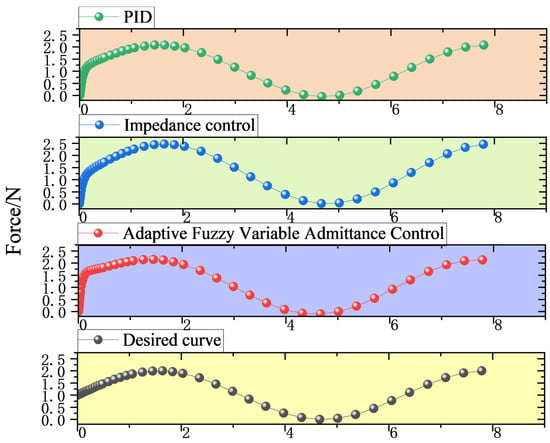
Figure 11.
Simulink simulation results of different control methods.
3.2. Experiments and Results
In the test 1, a six-degree-of-freedom multi-technique abdominal massage robot was applied to a silicone dummy with a shape simulating the human abdomen and real human bodies. The data of all key points were collected in combination with the key-point model. The least squares method was used to fit a curve of the comfortable force range of the abdomen, which is a quartic polynomial, as the expected curve, and a section of it was selected as the expected curve [], as shown in Figure 12b and Figure 13b. Experimental procedure of the control strategy: Wipe the key points on the abdomen with alcohol cotton to reduce the radial friction during the massage. Use the six-degree-of-freedom multi-technique abdominal massage robot to press successively at different positions on the abdomen. The order of the pressing points is from the ascending colon through the transverse colon to the descending colon, and then to the sigmoid colon. After the pressing of the current point is completed, the push rod moves to the next point during the pressing process, maintaining the current force magnitude during the movement, and tracking the expected force of all points at the same time. After the massage is completed, output the information of the pressure sensors at all points and fit the curve. The output of the pressure sensors of the massage actuator at the end of the robot is shown in Figure 12b and Figure 13b. Each change segment in the figure represents the change in the force at each massage point, and one segment with a total of four points is selected. The results of Test 1 can be seen in Table 5.
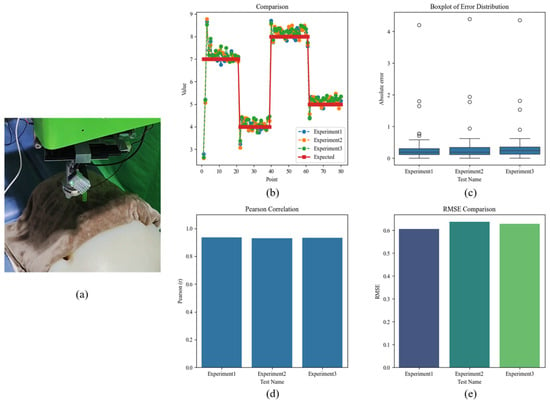
Figure 12.
(a) The robot was tested on a silicone dummy with a human abdominal shape; (b) the comparison between the expected curve and the actual cubic test curve; (c) the error box diagram of the third experiment (The small circles in the figure represent the outliers in the data); (d) the Pearson correlation coefficient; and (e) the margin of error.
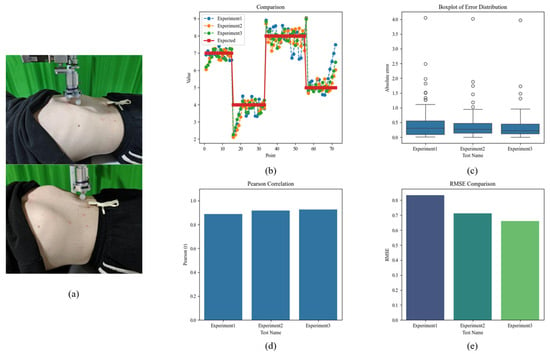
Figure 13.
(a) Robots in human experiments; (b) comparison of the expected curve and actual cubic test curve; (c) error box diagram of the cubic experiment (The small circles in the figure represent the outliers in the data); (d) Pearson correlation coefficient; and (e) margin of error.

Table 5.
Comparison of robot experiments on silicone dummies and evaluation indicators in human experiments.
From Figure 12b and Figure 13b, it can be obtained that the expected massage force applied by the massage head is consistent with the desired curve. Through data analytics, the average absolute error maximum value of the entire prosthesis experimental control process is 0.3391 N, and the average absolute error maximum value during the body experiment is 0.5157 N. The experimental results verify that the massage robot end massage actuator can closely track the preset massage force curve, showing excellent tracking accuracy and response speed, ensuring the efficient execution of the rehabilitation massage task.
4. Discussion
This study introduced a novel six-degree-of-freedom multi-technique abdominal massage robot system. The innovative series–parallel structure is a breakthrough. It enables full-abdomen projection coverage, ensuring that the massage can be effectively applied across different abdominal areas. The adjustable massage angle further enhances the adaptability to diverse user abdominal characteristics, catering to a wide range of user needs. In terms of function, the system can perform six-degree-of-freedom abdominal massage in a clockwise direction and support four standard massage techniques, namely pressing, vibrating, pushing, and kneading. This provides multi-dimensional abdominal stimulation, not only mimicking traditional massage techniques but also offering users a diverse range of comfortable massage experiences.
The newly proposed key-point model for abdominal massage action positioning is a remarkable feature. Analyzing the correlation between acupoints and human body surface characteristics allows for accurate abdominal massage trajectory positioning without relying on complex machine vision technology. This simplifies the robot’s position judgment during massage and reduces system complexity. In terms of software control, the combination of admittance control, PID control, and adaptive fuzzy control technologies forms an efficient closed-loop control system. This system enables the robot to precisely track the desired force curve during abdominal massage trajectory planning, ensuring precise force and displacement adjustment, as well as user comfort and safety. When compared with wearable massage devices, this robot demonstrates more advanced techniques, higher intelligence, and better precise control capabilities for massage positions and forces. Compared to non-wearable robotic arms or large-scale massage platforms, it has a higher degree of technique integration, a more moderate volume, and can combine multiple complex techniques in a limited space at a lower cost. This makes it more accessible to a wider range of users.
However, the system has several limitations. In terms of mechanical structure, to implement four massage techniques, although the system integration has been improved, the number of motors is still relatively large. This leads to an increase in the weight and volume of the robot. In terms of control precision, the adaptive fuzzy controller has achieved some results, but there is a slight overshoot. The main causes are unstable friction of the massage actuator due to abdominal contour fluctuations during supine breathing and uneven soft-tissue stiffness, which affect horizontal force detection. Also, the 485 communication protocol delays multi-motor command execution, reducing response speed.
There are the following improvement directions in the future:
Respiration-related force control accuracy: During massage, patients’ supine breathing causes abdominal contour fluctuations. Along with uneven soft-tissue stiffness, this leads to unstable friction in the massage actuator, affecting horizontal force detection. As a result, there is a deviation between actual and desired massage forces, reducing force control accuracy. To solve this, our team is currently researching the use of vision technology to monitor abdominal displacement changes. By combining filtering algorithms to remove respiratory interference, we aim to optimize the force control strategy for better accuracy.
Research on the robustness of the control algorithm: The adaptive fuzzy control strategy adopted in this study takes into account patient individual differences to a certain extent, but its ability to handle changes in patient anatomical structure and tissue stiffness still needs further evaluation. There are significant differences in the abdominal anatomical structure and tissue stiffness among different patients. To enhance the robustness of the control algorithm, we are currently researching an abdominal variable-stiffness physical model. We are recruiting force–displacement data from healthy subjects with different body shapes and ages to establish a more complete database. In the future, we plan to use these data to derive the abdominal variable-stiffness physical model and predict the abdominal massage interaction force. This is expected to train and optimize the control algorithm, enabling the algorithm to automatically adjust control parameters according to the specific conditions of patients to adapt to different anatomical structures and tissue stiffness changes.
Exploration of the long-term reliability of system performance: The system has demonstrated stable performance advantages during the experimental verification stage. To improve portability, the system currently adopts a lithium-battery-powered solution. Under full-load operation, the lithium battery can only provide about 4 h of working time. Since the basic clinical massage cycle is approximately 15 min, the stability of the system during long-term operation has not been addressed in this study. In future research, the design concept of the power supply board will be improved, and the circuit system will be optimized to be able to use both lithium batteries and external circuits simultaneously, to verify the performance of the robot system under long-term working conditions.
Error Analysis and Statistical Significance Testing: Although the error between the actual and desired massage forces have been analyzed in this paper, the analysis is not comprehensive enough. In the future, more in-depth error analysis will be carried out. The research plan is to examine whether there are significant differences in errors among different abdominal regions and patient groups. If significant differences exist, the reasons will be further explored to optimize the control strategy and improve the control accuracy of the massage force.
5. Conclusions
This research has successfully developed a novel six-degree-of-freedom multi-technique abdominal massage robot system. The system’s innovative series–parallel structure, along with the newly proposed abdominal massage action positioning model and advanced software control system, represents a significant step forward in the field of abdominal massage robotics.
Functionally, the system has demonstrated the ability to execute standardized massage techniques with high precision. It can accurately position the massage trajectory and precisely control the massage force, thereby ensuring a comfortable and safe massage experience for users. In a comprehensive comparison with existing abdominal massage devices and robots, this new system has shown clear superiority in multiple aspects. It offers a wider variety of techniques, a higher level of intelligence, a greater degree of integration, a more compact and suitable volume, and a lower cost, making it more accessible and applicable in various scenarios.
Several potential future research directions have been identified. Firstly, in terms of structural simplification, efforts should be directed towards reducing the number of motors through innovative mechanical design, such as the development of more efficient transmission mechanisms or integrated actuators. This will contribute to decreasing the weight and volume of the robot, further enhancing its portability and ease of use. Secondly, considering the influence of the human respiration rhythm and the complex mechanical properties of abdominal soft tissues on control accuracy, optimizing the abdominal safe force interaction strategy is of great significance. This may involve the development of more advanced algorithms, for example, by adopting more sophisticated sensor fusion techniques to track the human respiration rhythm and detect the characteristics of the variable-stiffness model of abdominal soft tissues. The delay caused by the communication protocol also requires upgrading sensors to improve force detection accuracy and developing compensation algorithms to address this. Thirdly, due to the high safety requirements for abdominal massage, future research should explore high-performance and long-term reliable hardware components to better adapt to the complex abdominal environment and potential long-term load working requirements. Meanwhile, the safety control strategy should be further strengthened, for example, by introducing more redundant safety mechanisms and real-time safety monitoring systems. These future research directions will not only contribute to the continuous improvement of the abdominal massage robot system but also provide valuable insights for the development of related technologies in the broader context of medical robotics.
Author Contributions
Conceptualization, P.S.; methodology, H.Y.; software, Z.L.; formal analysis, X.T. and Z.L.; investigation, X.T.; resources, H.Y.; writing—original draft preparation, X.T. and Z.L.; writing—review and editing, X.T.; visualization, X.T.; project administration, P.S.; funding acquisition, H.Y. and P.S. All authors have read and agreed to the published version of the manuscript.
Funding
This research was supported by the National Key Research and Development Program of China(Grant No. 2022YFB4703300).
Data Availability Statement
The original contributions presented in the study are included in the article. Further inquiries can be directed to the corresponding author.
Conflicts of Interest
The authors declare no conflicts of interest.
References
- Sinclair, M. The Use of Abdominal Massage to Treat Chronic Constipation. J. Bodyw. Mov. Ther. 2011, 15, 436–445. [Google Scholar] [CrossRef] [PubMed]
- Gallegos-Orozco, J.F.; Foxx-Orenstein, A.E.; Sterler, S.M.; Stoa, J.M. Chronic Constipation in the Elderly. Am. J. Gastroenterol. 2012, 107, 18–25. [Google Scholar] [CrossRef]
- Sharma, A.; Rao, S. Constipation: Pathophysiology and Current Therapeutic Approaches. In Handbook of Experimental Pharmacology; Springer: Cham, Switzerland, 2017; Volume 239, pp. 59–74. [Google Scholar]
- Goldenberg, M.; Kalichman, L. The Underlying Mechanism, Efficiency, and Safety of Manual Therapy for Functional Gastro-intestinal Disorders: A Narrative Review. J. Bodyw. Mov. Ther. 2024, 38, 1–7. [Google Scholar] [CrossRef] [PubMed]
- Vigano, A.; Bruera, E. Pain Management in Functional Gastrointestinal Disorders. Can. J. Gastroenterol. Hepatol. 1995, 9, 802590. [Google Scholar] [CrossRef]
- Dehghan, M.; Malakoutikhah, A.; Ghaedi Heidari, F.; Zakeri, M.A. The Effect of Abdominal Massage on Gastrointestinal Functions: A Systematic Review. Complement. Ther. Med. 2020, 54, 102553. [Google Scholar] [CrossRef]
- Wang, G.; Zhang, Z.; Sun, J.; Li, X.; Chu, Y.; Zhao, D.; Ju, H.; Wu, X.; Cong, D. Abdominal Massage: A Review of Clinical and Experimental Studies from 1990 to 2021. Complement. Ther. Med. 2022, 70, 102861. [Google Scholar] [CrossRef]
- Chen, Q.; Zhou, Z.; Liao, Y. Clinical Observation on the Treatment of Constipation after Thoracolumbar Fracture with Acupoint Massage Combined with Application. Chin. Med. Mod. Distance Educ. China 2025, 23, 111–113. [Google Scholar]
- Xiao, S.S.; Huang, L.S.; Wang, L.; Xu, Y. Application of Abdominal Acupoint Massage Combined with Chewing Gum in Preventing Constipation in Patients after Posterior Lumbar Interbody Fusion. J. Qilu Nurs. 2024, 30, 121–123. [Google Scholar]
- Wang, T.T.; Fang, Q. Effects of Abdominal Acupoint Massage Combined with Moxibustion Therapy on Defecation and Quality of Life in Parkinson’s Constipation Patients. Clin. Res. Pract. 2024, 9, 175–178. [Google Scholar] [CrossRef]
- Smith, G.D. Abdominal Massage for Constipation: Techniques, Evidence Base and Safety. Gastrointest. Nurs. 2013, 11, 13–14. [Google Scholar] [CrossRef]
- Mimidis, K.; Galinsky, D.; Rimon, E.; Papadopoulos, V.; Zicherman, Y.; Oreopoulos, D. Use of a Device That Applies External Kneading-like Force on the Abdomen for Treatment of Constipation. World J. Gastroenterol. 2005, 11, 2027–2031. [Google Scholar] [CrossRef] [PubMed]
- Mowoot II. Available online: https://www.mowoot.com/en/product/mowoot-2/#moreinfo (accessed on 9 February 2025).
- Mcclurg, D.; Booth, L.; Herrero-Fresneda, I. Safety and Efficacy of Intermittent Colonic Exoperistalsis Device to Treat Chronic Constipation: A Prospective Multicentric Clinical Trial. Clin. Transl. Gastroenterol. 2020, 11, e00267. [Google Scholar] [CrossRef] [PubMed]
- Li, H.Y.; Wang, M.; Li, N. Intestinal Management Training Massager. Patent CN205515489U, 31 August 2016. [Google Scholar]
- Li, H.Y.; Zhao, H.; Gong, Z.K. Application of a New Intestinal Massager in Stroke Patients with Constipation. Chin. Nurs. Res. 2018, 32, 636–638. [Google Scholar]
- Kim, T.Y.; Moon, S.I. Device for Treating Constipation Using Heat and Air Cells. Patent KR200452102 Y1, 27 November 2018. [Google Scholar]
- Choi, Y.I.; Kim, K.O.; Chung, J.W.; Kwon, K.A.; Kim, Y.J.; Kim, J.H.; Park, D.K. Effects of Automatic Abdominal Massage Device in Treatment of Chronic Constipation Patients: A Prospective Study. Dig. Dis. Sci. 2020, 66, 3105–3112. [Google Scholar] [CrossRef]
- Ning, P.F. A Nursing Massage Robot for Promoting Digestion. Patent CN109498397A, 22 March 2019. [Google Scholar]
- Zhu, H.L. A New Type of Abdominal Massage Device. Patent CN202020731814, 7 May 2020. [Google Scholar]
- Gou, Y.Q.; Yang, L.X. An Abdominal Massage Device for Gastroenterology. Patent CN211750916U, 27 October 2020. [Google Scholar]
- Jones, K.C.; Du, W. Development of a massage robot for medical therapy. In Proceedings of the 2003 IEEE/ASME International Conference on Advanced Intelligent Mechatronics, Honolulu, HI, USA, 2–5 June 2003. [Google Scholar]
- Aitreat-About Emma. Available online: https://www.aitreat.com/about-emma (accessed on 6 March 2025).
- Kuka-Solutions Database. Available online: https://www.kuka.cn/zh-cn (accessed on 6 March 2025).
- Hou, P.; Han, L. Development of a Home-use Back-rubbing and Massage Robot. Mach. Des. Res. 2009, 25, 101–105. [Google Scholar] [CrossRef]
- Jiao, C.B. Structural Analysis and Optimization of the LLR-1 Traditional Chinese Medicine Massage and Physiotherapy Robot. Master’s Thesis, Shandong Jianzhu University, Jinan, China, 2012. [Google Scholar]
- Lu, S.; Gao, H.; Liu, C.; Wang, T. Design of Chinese medical massage robot system. In Proceedings of the 2011 International Conference on Electrical and Control Engineering, Yichang, China, 16–18 September 2011. [Google Scholar]
- Gao, H.B.; Lu, S.Y.; Wang, T.; Liu, C.G.; Kang, B.Y.; Ji, Y.; Bi, H.Y. Research and Development of a Traditional Chinese Medicine Massage Robot. Robot 2011, 33, 553–562. [Google Scholar]
- Xie, J.; Zhang, J.; Ma, L.Z.; Yang, Q.Z.; Yin, X.Q. Mechanism Design and Motion Simulation of a Traditional Chinese Medicine Tuina Manipulator. J. Eng. Des. 2011, 18, 344–348. [Google Scholar]
- Lu, S.Y.; Li, C. Research Progress on Key Technologies of Traditional Chinese Medicine Massage Robots. J. Shandong Jianzhu Univ. 2017, 32, 60–68. [Google Scholar]
- Wang, Y.R. System Analysis and Prospect of Traditional Chinese Medicine Massage Robots. Inf. Technol. Informatiz. 2012, 76–79. [Google Scholar]
- Tao, W.; Liu, Z.; Li, Y. Research and realization of the Chinese massage robot based on three-dimensional model. In Proceedings of the 2010 8th World Congress on Intelligent Control and Automation, Jinan, China, 27–29 June 2010. [Google Scholar]
- Su, Y.L. Design and Research of a Tuina Robot Based on a Decoupled Parallel Mechanism. Ph.D. Thesis, Yanshan University, Qinhuangdao, China, 2015. [Google Scholar]
- Kong, Y.X. Design and Research of a Hybrid-connected Robot Based on Traditional Chinese Medicine Tuina Manipulation. Ph.D. Thesis, North University of China, Taiyuan, China, 2021. [Google Scholar] [CrossRef]
- Aubo-Robotic. Available online: https://www.aubo-robotics.cn/cases_m (accessed on 6 March 2025).
- Universal Robots. Available online: http://www.universal-robots.com/ (accessed on 6 March 2025).
- Grebenstein, M.; Albu-Schaffer, A.; Bahls, T.; Chalon, M.; Eiberger, O.; Friedl, W.; Gruber, R.; Haddadin, S.; Hagn, U.; Haslinger, R.; et al. The DLR hand arm system. In Proceedings of the 2011 IEEE International Conference on Robotics and Automation, Shanghai, China, 9–13 May 2011. [Google Scholar]
- Huang, Z.; Yu, C.; Yu, Z.; Long, R.; Li, Y.; Li, Y. Soft Four-Leaf Clover Physiotherapy Robot for Traditional Chinese Medicine Massage Physiotherapy. In Proceedings of the 2023 China Automation Congress (CAC), Chongqing, China, 24–26 November 2023; pp. 1977–1982. [Google Scholar]
- Zhang, B.C.; Han, Y.Y.; Wang, Z.L.; Pang, Z.X.; Zhang, Y.L. Design of the Arm Control System of a Humanoid Massage Robot Based on PMAC. Mach. Des. Manuf. 2012, 4, 56–58. [Google Scholar]
- Si, W.; Srivastava, G.; Zhang, Y.; Jiang, L. Green Internet of Things Application of a Medical Massage Robot With System Interruption. IEEE Access 2019, 7, 127066–127077. [Google Scholar] [CrossRef]
- Dong, H.; Feng, Y.; Qiu, C.; Chen, I.-M. Construction of interaction parallel manipulator: Towards rehabilitation massage. IEEE/ASME Trans. Mechatron. 2022, 28, 372–384. [Google Scholar] [CrossRef]
- Khoramshahi, M.; Henriks, G.; Naef, A.; Salehian, S.S.M.; Kim, J.; Billard, A. Arm-hand motion-force coordination for physical interactions with non-flat surfaces using dynamical systems: Toward compliant robotic massage. In Proceedings of the 2020 IEEE International Conference on Robotics and Automation (ICRA), Paris, France, 31 May–31 August 2020. [Google Scholar] [CrossRef]
- Luo, R.C.; Hsieh, K.C. Tapping motion detection incorporate with impedance control of robotics tapotement massage on human tissue. In Proceedings of the 2018 IEEE 15th Int Workshop Advanced Motion Control (AMC), Nagoya, Japan, 10–12 April 2018; pp. 160–165. [Google Scholar]
- Meng, X.; Tie, Z.; Wen, X.W. Study on force control for robot massage with a model-based reinforcement learning algorithm. Intell. Serv. Robot. 2023, 16, 509–519. [Google Scholar]
- Zhang, X.; Xiong, G.; Yin, P.; Gao, Y.; Feng, Y. Autonomous path planning and stabilizing force interaction control for robotic massage in unknown environment. Ind. Robot 2024, 51, 518–527. [Google Scholar] [CrossRef]
- GB/T 12346-2021; Nomenclature and Location of Meridian Points. China Standards Press: Beijing, China, 2021.
- GB/T 23237-2009; Methods of Anthropometry for Locating Acupuncture Points. China Standards Press: Beijing, China, 2009.
- Mouri, K.; Terashima, K.; Minyong, P.; Kitagawa, H.; Miyoshi, T. Identification and hybrid impedance control of human skin muscle by multi-fingered robot hand. In Proceedings of the IEEE/RSJ International Conference on Intelligent Robots and Systems, Nice, France, 22–26 September 2008. [Google Scholar]
- Wang, W.; Wang, S.Y.; Zhang, T.Q.; Yang, J.Y. Control Method of a Wheeled Walking-aid Robot Based on the DDPG Algorithm of Reinforcement Learning. Robot. Technol. Appl. 2023, 39–43. [Google Scholar]
- Shi, S.K.; Diao, Y.; Yang, J.B.; Yang, S.Y.; You, D.H.; Wang, F. Research on the Impedance Control of a Non-metallic Curved Surface Local Grinding and Polishing Repair Robot. Modul. Mach. Tool Autom. Manuf. Technol. 2023, 8, 57–61. [Google Scholar] [CrossRef]
- Zhai, J.; Zeng, X.; Su, Z. An intelligent control system for robot massaging with uncertain skin characteristics. Ind. Robot 2022, 49, 634–644. [Google Scholar] [CrossRef]
- Tan, J.Y.; Wei, S.B.; Rong, Y.S.; Zhang, Z.L. Research on the Contact Force Tracking of a Robot Based on Variable-damping Impedance Control. Modul. Mach. Tool Autom. Manuf. Technol. 2021, 5, 69–71, 76. [Google Scholar] [CrossRef]
- Zhai, J.; Li, R.; Su, Z. Friction and Deformation Behavior of Human Skin During Robotic Sliding Massage Operation. J. Bionic Eng. 2024, 21, 1892–1904. [Google Scholar] [CrossRef]
- Filipe, J.; Terashima, K.; Kitagawa, H.; Miyoshi, T.; Minyong, P.; Kondo, T. Modeling and massage control of human skin muscle by using multi-fingered robot hand. Integr. Comput.-Aided Eng. 2006, 13, 233–248. [Google Scholar]
- Li, G.; Tao, L.; Meng, J.; Ye, S.; Feng, G.; Zhao, D.; Hu, Y.; Tang, M.; Song, T.; Fu, R.; et al. Research on mode adjustment control strategy of upper limb rehabilitation robot based on interactive force fuzzy recognition. J. Biomed. Eng. 2018, 41, 90–97. [Google Scholar]
- Zhou, Z.; Meng, W.; Ai, Q.; Liu, Q.; Wu, X. Practical Velocity Tracking Control of a Parallel Robot Based on Fuzzy Adaptive Algorithm. Adv. Mech. Eng. 2019, 5, 574896. [Google Scholar] [CrossRef]
- Arkhipov, M.V.; Kocherevskaya, L.B.; Matrosova, V.V. Control of Manipulation Robot Interacting with Elastic Objects Using Simmechanics. In Proceedings of the 2021 International Conference on Industrial Engineering, Applications and Manufacturing (ICI-EAM), Sochi, Russia, 24–28 May 2021. [Google Scholar] [CrossRef]
- Wang, L.; Li, C.; Liu, Y.; Zhang, J. Experimental Research on Force-based Impedance Control of Arm Rehabilitation Robot. China Mech. Eng. 2008, 19, 1518–1522. [Google Scholar]
- Gao, J.; Liu, L.; Wang, J.; Li, X.; Ding, S.; Gao, Y.; Wang, X. Upper limb rehabilitation robot based on fuzzy control variable admittance control. J. Zhengzhou Univ. (Eng. Sci.) 2024, 2024, 12–20. [Google Scholar]
Disclaimer/Publisher’s Note: The statements, opinions and data contained in all publications are solely those of the individual author(s) and contributor(s) and not of MDPI and/or the editor(s). MDPI and/or the editor(s) disclaim responsibility for any injury to people or property resulting from any ideas, methods, instructions or products referred to in the content. |
© 2025 by the authors. Licensee MDPI, Basel, Switzerland. This article is an open access article distributed under the terms and conditions of the Creative Commons Attribution (CC BY) license (https://creativecommons.org/licenses/by/4.0/).